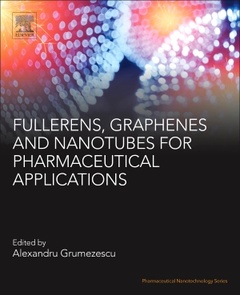Description
Fullerens, Graphenes and Nanotubes
A Pharmaceutical Approach
Pharmaceutical Nanotechnology Series
Coordinator: Grumezescu Alexandru Mihai
Language: English
Subjects for Fullerens, Graphenes and Nanotubes:
Keywords
Aerobic model oxidation of hydrocarbons; Anticancer therapy; Antimicrobial activity; Antioxidative activity; Bacterial pathogens; Bioactive substances; Bioavailability; Biocompatibility; Biodistribution; Biomedical applications; Biosensors; CNTs; Cancer; Carbon dots; Carbon fullerene; Carbon nanofibers; Carbon nanomaterials; Carbon nanopillow; Carbon nanostructure-based electrodes; Carbon nanotubes; Characterization; Chromatography; Clinical diagnosis; Clove oil; Cytotoxicity; Diagnosis; Diagnostics; Dispersive solid phase extraction; Drug delivery; Drug delivery systems; Drug targeting; Electroanalysis; Electrochemical cells; Electrochemical sensors; Electrochemical techniques; Electrospinning; Extremely resistant; Fullerenes; Functionalization; Graphene; Graphene oxide; Graphene oxide nanoplatelets; Graphene quantum dots; Graphenes; Hybrid graphene; Ideal lead molecules; Immune factors; Inorganic nanoparticles; Light emitters; Magnetic carbon nanotubes; Magnetic solid phase extraction; Nanomaterials; Nanomedicine; Nanotubes; Oxidation rate constants; Oxidation rates; Perioceutics; Periopathogens; Pharmaceutical applications; Pharmaceuticals; Photodynamic; Photothermal; Polymer composites; Polymer nanocomposite scaffolds; Probable drug targets; Quantum dots; Radical scavenging efficiency; Scaffolds; Solid phase extraction; Stem cells; Therapeutic; Therapeutic potential; Thermal analysis; Thermooxidative stability of polyolefines; Tissue engineering; Tissue regeneration; Toxicity
724 p. · 19x23.3 cm · Paperback
Description
/li>Contents
/li>Biography
/li>Comment
/li>
Fullerens, Graphenes and Nanotubes: A Pharmaceutical Approach shows how carbon nanomaterials are used in the pharmaceutical industry. While there are various books on the carbonaceous nanomaterials available on the market, none approach the subject from a pharmaceutical point-of-view. In this context, the book covers different applications of carbonaceous nanomaterials. Chapters examine different types of carbon nanomaterials and explore how they are used in such areas as cancer treatments, pulse sensing and prosthetics. Readers will find this book to be a valuable reference resource for those working in the areas of carbon materials, nanomaterials and pharmaceutical science.
2. Carbon nanocrystals as controlled drug delivery systems and combined imaging probes
3. Role of immune factors on bioavailability of carbon nanomaterials
4. Carbon Nanomaterials in Pharmaceutical Nanotechnology
5. Polymer based graphene oxide/calcium phosphate coated on titanium implants act as a prosthetic device
6. Graphene-based materials for application in pharmaceutical nanotechnology
7. Graphene based nanomaterials in cancer treatment and diagnosis
8. (ThreeDimensional (3D) Bio-responsive Nanosubstrates for Enhanced Cellular Interactions
9. Hybridized Graphene Nanomaterials for Electrochemical Biosensors and Drug Delivery Applications
10. Functionalized Graphene-based Nanomaterials for Drug Delivery and Biomedical Applications in Cancer Chemotherapy
11. Carbon Nanomaterials for Electroanalysis in Pharmaceutical Applications
12. Exploring the Binding Potential of Carbon Nanotubes and Fullurene Towards Major Drug Targets of Multidrug Resistant Bacterial Pathogens and their Utility as Novel Therapeutic Agents
13. Comparison of Various Techniques for Characterisation of Nanodiamods: Atomic Force Microscopy, Electron Microscopy, Dynamic and Multiangle Light Scattering, Nanoparticle Tracking Analysis, Field Flow Fractionation, Centrifugal Flow Fractionation, Resistive Pulse Sensing and Resonant Mass Measurement
14. Elevating Towards a New Innovation- Carbon Nanotubes (CNTs)
15. Quantum Chemistry and Machine Learning Modeling of Electronic Properties of Graphene Nanoflakes
16. Carbon nanotubes: A review of toxicity and applicability in biomedical applications
17. Carbonaceous nanocompounds in aerobic oxidation processes of hydrocarbons and polyolefines
- Explains how the unique properties of carbon-based nanomaterials allow them to be used to create effective drug delivery systems
- Covers how carbon-based nanomaterials should be prepared for use in pharmaceutical applications
- Discusses the relative toxicity of a range of carbon-based nanomaterials
- Considers the safety of their use in different types of drugs
These books may interest you

Nanobiosensors and Nanobioanalyses 158.24 €

Nanobiosensors and Nanobioanalyses 158.24 €


